Today, fitness apps aren’t just an add-on; they’re a go-to for millions looking to stay healthy on their own terms.
They bring personal trainers, diet trackers, and wellness routines straight to users’ fingertips.
For businesses, creating a fitness app isn’t about following a trend, it’s an opportunity to tap into a growing market, build loyal communities, and offer tools that genuinely help people lead healthier lives.
Whether you’re a startup venturing into health tech or an established brand aiming to reach new customers, this guide breaks down everything you need to know.
From the latest stats to must-have features, here’s what it takes to develop a fitness app that fits right into the lives of today’s users.
Fitness App Market: Key Statistics to Know
The fitness app market is experiencing remarkable growth in 2024, presenting a lucrative opportunity for businesses aiming to develop a fitness app. Here are some key statistics highlighting this trend:
-
-
Market Size: The global fitness app market is projected to reach $6.86 billion in 2024, with an expected annual growth rate of 7.96% from 2024 to 2029, leading to a market volume of $10.06 billion by 2029. (Statista)
-
User Base: Fitness apps had 368 million users in 2023, indicating a substantial and growing user base. (Business of Apps)
-
Revenue Growth: Fitness apps generated $3.58 billion in revenue in 2023, marking a 9.1% increase from the previous year. (Business of Apps)
-
Download Rates: Fitness apps were downloaded over 850 million times in 2023, reflecting their widespread adoption. (Business of Apps)
-
Average Revenue Per User (ARPU): The ARPU in the fitness apps market is expected to amount to $17.84 in 2024. (Statista)
-
Regional Insights: In global comparison, most revenue will be generated in the United States, amounting to $2,061 million in 2024. (Statista)
-
Wearable Integration: Approximately 58% of fitness app users sync their app with a wearable device, underscoring the trend toward seamless health tracking across platforms. (Grand View Research)
-
Age Demographics: The highest user engagement is among the 18–34 age group, which represents nearly 60% of fitness app users globally. (Exercise)
-
Retention Rates: On average, fitness apps see a 30-day retention rate of about 40%, making consistent engagement a key metric for success. (Exercise)
-
Preferred Features: Over 65% of users cite workout tracking, diet planning, and personalized recommendations as essential features. (Exercise)
-
These statistics underscore the robust expansion and lucrative potential of the fitness app industry in 2024, making it an opportune time to invest in developing a fitness app.
Understanding Fitness Apps: What They Offer
A fitness app is a digital tool designed to support users in managing various aspects of their health and wellness. These apps provide a range of functionalities, from tracking workouts and monitoring diet to offering personalized coaching and wellness routines. With advancements in technology, many fitness apps now integrate with wearables, giving users real-time insights and data-driven recommendations.
At their core, fitness apps make healthy living more accessible, interactive, and customizable. Users can set goals, monitor progress, and receive encouragement—whether they’re focusing on weight loss, strength training, or mindfulness. By combining convenience with powerful features, fitness apps empower users to take charge of their health journeys, anytime and anywhere.
Here’s the Types of Fitness Apps and Popular Examples section. This part explains the main categories of fitness apps and provides examples for each type.
Types of Fitness Apps and Popular Examples

When you’re planning to build a fitness app, knowing the different categories can help you decide which type will best meet your audience’s needs.
Each category offers unique features and serves distinct purposes, and choosing the right type can significantly impact user engagement.
Here are the major types of fitness apps with popular examples for inspiration:
1. Workout and Exercise Tracking Apps
These apps are designed to help users monitor their workout sessions, set goals, and track progress.
They often provide pre-designed workout plans or customizable routines.
Examples include MyFitnessPal for detailed exercise logging and Strava for tracking runs and cycling activities.
2. Activity Tracking Apps
Perfect for users who want to stay active daily, activity trackers monitor physical activities like walking, running, or general movement.
Apps like Google Fit and Apple Health fall into this category, syncing with wearables to provide data on steps, distance, and calories burned.
3. Diet and Nutrition Apps
Nutrition apps focus on helping users maintain healthy eating habits by tracking their meals, calories, and nutritional intake.
Some apps even provide personalized meal plans based on user goals.
Lose It! and Yazio are great examples of apps that guide users through diet management.
For users focusing on medical weight loss, it’s important to note that some fitness and nutrition apps are starting to integrate prescription services for medications like Ozempic. With demand rising, many individuals research the price of Ozempic and seek online solutions for obtaining prescriptions conveniently. Integrating resources or links to online prescription options within your app can empower users looking for a more comprehensive wellness approach—enabling seamless information access about costs and digital prescribing alongside their daily fitness tracking.
4. Personal Training and Coaching Apps
These apps connect users with virtual trainers or provide AI-powered coaching to guide users through workouts.
Freeletics and Fitbod use adaptive training plans based on fitness levels, allowing users to have a personalized experience similar to having a personal trainer.
5. Mindfulness and Meditation Apps
Focused on mental wellness, these apps offer guided meditations, breathing exercises, and stress-relief techniques.
Apps like Headspace and Calm have gained popularity for their wide range of sessions targeting anxiety, relaxation, and mindfulness.
6. Yoga and Stretching Apps
For users interested in flexibility, relaxation, and strength, yoga and stretching apps provide step-by-step routines and often include video guidance.
Down Dog and Glo offer yoga classes for all levels, making them popular choices for yoga enthusiasts.
7. Social Fitness Apps
These apps encourage users to connect with friends, share progress, and join challenges, turning fitness into a social activity.
Fitocracy and Zombies, Run! add a social and gamified element to workouts, motivating users through friendly competition and community support.
8. Specialized Fitness Apps
Some fitness apps focus on niche activities like cycling, bodybuilding, or HIIT.
Peloton for cycling classes and Strong for weightlifting are examples of specialized apps that cater to enthusiasts in specific fitness areas.
By understanding these types, you can create a fitness app that fits the specific goals of your target audience, whether they’re looking to lose weight, get stronger, or stay active.
The Top Fitness Apps for Inspiration
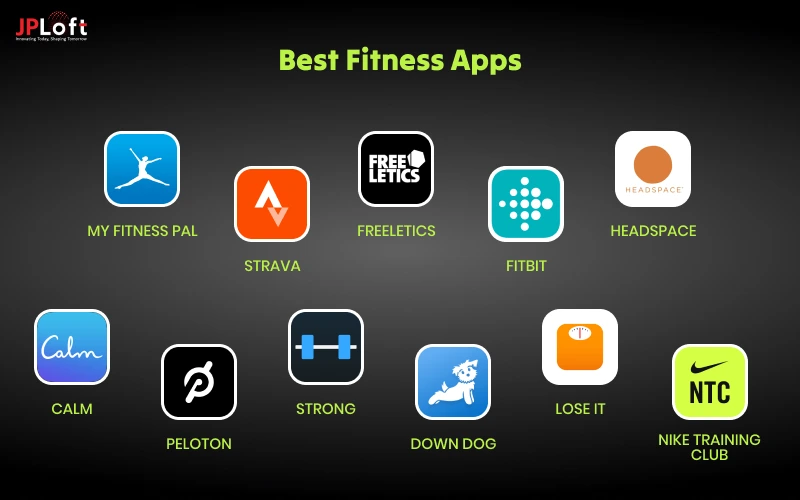
Analyzing popular fitness apps offers a wealth of ideas for developing a fitness app that stands out.
Here are 11 top-rated fitness apps, their standout features, and key takeaways to inspire your own project:
1. MyFitnessPal
Known for its vast food database and calorie tracker, MyFitnessPal simplifies logging meals with barcode scanning and personalized nutrition goals.
-
-
Takeaway: Simplify logging for users by offering an extensive database and tools like barcode scanning, which improve convenience and user engagement.
-
2. Strava
Popular among runners and cyclists, Strava combines GPS tracking with social networking, allowing users to share routes and compete with others.
-
-
Takeaway: Integrate social features to foster community and competition, as this can drive user retention and encourage consistent app use.
-
3. Nike Training Club
This app offers professionally curated workouts across various fitness levels, from beginner to advanced, along with video-guided sessions.
-
-
Takeaway: Providing a mix of beginner-friendly and advanced workouts with video guidance enhances inclusivity and usability for a diverse audience.
-
4. Fitbit
Primarily a wearable brand, Fitbit’s app syncs with its devices to track health metrics like steps, heart rate, and sleep patterns in real-time.
-
-
Takeaway: Integrate with popular wearables to give users continuous health insights, adding a personalized, data-rich experience.
-
5. Headspace
Focused on mindfulness and mental wellness, Headspace offers guided meditation sessions and stress-relief exercises, promoting a holistic approach to fitness.
-
- Takeaway: Consider adding mindfulness and mental health resources, recognizing the growing interest in a well-rounded wellness journey.
6. Freeletics
Freeletics provides personalized workout plans that adapt based on user progress, featuring AI-driven coaching tailored to individual fitness levels.
-
-
Takeaway: Using AI to deliver adaptive coaching keeps users engaged by offering tailored routines that progress with them.
-
7. Calm
Calm specializes in sleep and relaxation resources with guided sessions for anxiety and stress relief, along with soothing background sounds.
-
-
Takeaway: Expand beyond fitness to include relaxation tools like sleep and stress management, addressing broader wellness goals.
-
8. Peloton
Known for its live and on-demand classes, Peloton delivers high-energy cycling, running, and strength classes led by professional instructors.
-
-
Takeaway: Offer live or interactive classes to create an engaging, immersive experience that users can enjoy from home.
-
9. Strong
Strong is designed for weightlifters, providing tracking tools for reps, sets, and weights while helping users log their progress.
-
-
Takeaway: For users with specific fitness goals, include tracking tools that allow them to measure progress in detail, building accountability and motivation.
-
10. Down Dog
This yoga app allows users to customize their practice by choosing focus areas, duration, and level, with beautiful video guides.
-
-
Takeaway: Customization options enhance user satisfaction, especially in activity-specific apps where personal preferences vary widely.
-
11. Lose It!
Focused on weight loss, Lose It! offers a calorie counter, meal planning, and goal-setting to help users stay on track.
-
-
Takeaway: Goal-oriented tracking with clear milestones and progress visualization can drive motivation and keep users engaged over time.
-
Each of these apps highlights unique approaches and features that cater to specific user needs, from social engagement to highly personalized coaching. When you build a fitness app, consider incorporating similar features tailored to your target audience, providing a comprehensive and engaging fitness experience.
Key Features for Fitness App Success
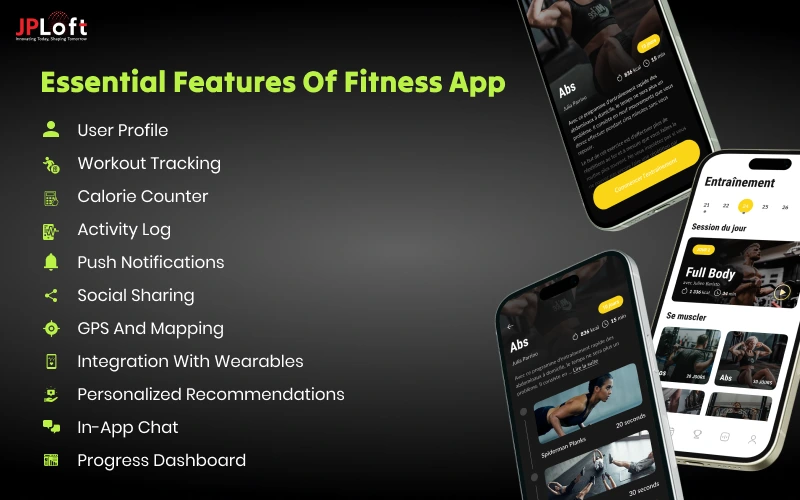
|
Feature Type |
Feature |
Description |
|
Essential Features |
User Profile |
Allows users to create profiles and set fitness goals for a personalized experience. |
|
Workout Tracking |
Enables users to log exercises, reps, and sets, making it easy to track progress. |
|
|
Calorie Counter |
Helps users track daily calorie intake, which is key for diet and nutrition management. |
|
|
Activity Log |
Logs various activities, such as running or cycling, for users to monitor their fitness journey. |
|
|
Push Notifications |
Sends reminders for workouts, challenges, or goals to keep users engaged and motivated. |
|
|
Social Sharing |
Allows users to share achievements and progress with friends or on social media, adding a social aspect. |
|
|
GPS and Mapping |
Tracks outdoor activities, providing stats on distance, pace, and routes. |
|
|
Integration with Wearables |
Syncs with devices like Fitbit or Apple Watch for real-time tracking of health metrics. |
|
|
Personalized Recommendations |
Delivers tailored workout and diet plans based on user data and preferences. |
|
|
In-App Chat |
Allows users to interact with trainers or a support community for guidance and motivation. |
|
|
Progress Dashboard |
Displays key fitness metrics over time, such as calories burned, distance covered, or weight changes. |
|
|
Advanced Features |
AI-Powered Coaching |
Provides adaptive workouts and coaching based on user performance, enhancing personalization. |
|
Live Streaming |
Allows users to join live classes, bringing real-time engagement and interaction. |
|
|
Video Tutorials |
Offers guided video workouts, helping users maintain correct form and technique. |
|
|
Goal Setting and Challenges |
Engages users by allowing them to set fitness milestones and join app-based challenges. |
|
|
Gamification |
Adds elements like badges, points, or leaderboards to make workouts fun and rewarding. |
|
|
Voice Feedback |
Provides real-time audio cues or motivational prompts during workouts. |
|
|
Integration with Smart TVs |
Enables users to stream workouts on larger screens for a better viewing experience. |
|
|
AR/VR Workouts |
Introduces virtual and augmented reality experiences to make exercises more immersive and engaging. |
|
|
Nutrition and Meal Plans |
Suggests meal plans or recipes tailored to individual dietary goals and restrictions. |
|
|
Health Metrics Tracking |
Monitors key health indicators like heart rate, blood pressure, and sleep patterns in one place. |
|
|
AI-Powered Analytics |
Analyzes user data to provide insights on progress, strengths, and improvement areas. |
Each feature contributes to creating a fitness app that is engaging, useful, and tailored to users’ needs.
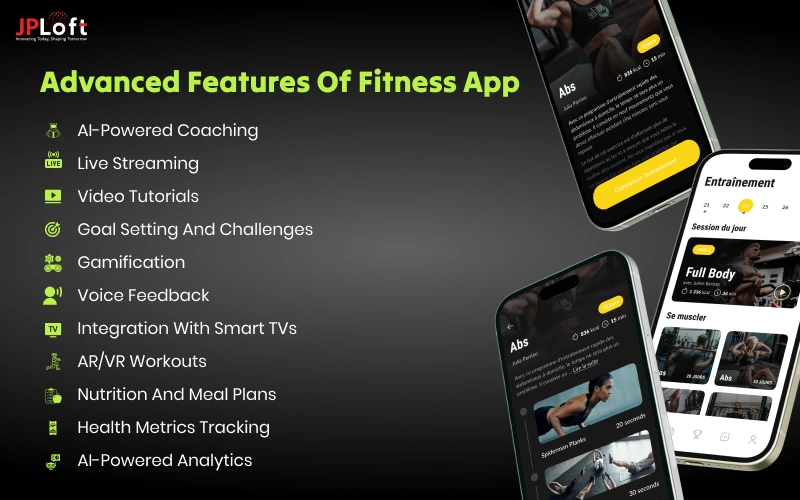
Why Invest in Developing a Custom Fitness App?
Developing a fitness app offers numerous opportunities for businesses looking to tap into the booming health and wellness market.
Here are three major reasons to invest in creating a custom fitness app, supported by statistics:
1. Rapidly Growing Market Demand
The global demand for fitness and wellness apps is on an upward trajectory.
In fact, the fitness app market is projected to reach $27.6 billion by 2024, with an annual growth rate of around 23% from 2021 to 2028 (Statista & Grand View Research).
Millions of users are actively seeking digital tools to support their health goals, which means a fitness app can connect you to this expanding audience and fulfill their needs for convenience and personalized wellness.
2. High Revenue Potential Through Multiple Monetization Options
Fitness apps present diverse revenue streams, from subscription models to in-app purchases, ads, and partnerships.
Revenue in the fitness app market was reported at $5.3 billion in 2023 and is expected to continue rising as users increasingly invest in their health (Business of Apps & Statista).
By developing a fitness app, businesses can capitalize on these income avenues, meeting users’ willingness to spend on quality health and wellness content.
3. Building Strong User Engagement and Brand Loyalty
A well-designed fitness app keeps users engaged through features like progress tracking, personalized recommendations, and social interactions.
Statistics show that the average fitness app user spends around 6 minutes per session, with high retention rates observed among active users (App Annie & Sensor Tower).
This engagement fosters brand loyalty and increases the likelihood of long-term retention, making fitness apps a reliable platform for continuous user interaction and growth.
Investing in a fitness app goes beyond following a trend; it’s about creating a valuable platform that meets users’ wellness needs while generating steady revenue and cultivating brand loyalty.
Here’s an expanded Step-by-Step Guide to Developing a Fitness App section, with a detailed breakdown of each phase. I’ve removed steps 9 and 10 and added a section on maintenance.
Step-by-Step Process to Developing a Fitness App
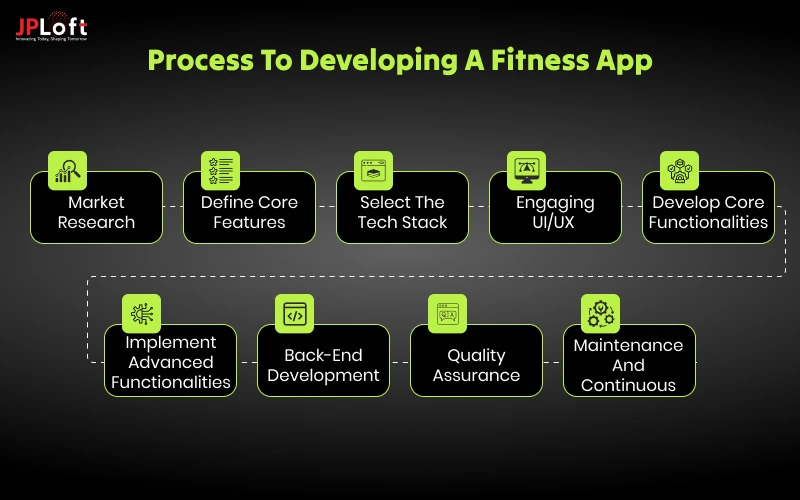
Building a custom fitness app involves careful planning and execution at each stage.
Here’s an in-depth look at the app development process, focusing on how to create a fitness app that stands out:
Step 1: Market Research and Audience Analysis
Thorough research is the foundation of successful fitness app development. Start by analyzing the fitness app market to identify top competitors, trends, and market gaps. Conduct audience research through surveys, focus groups, and analytics to understand user demographics, fitness goals, preferred features, and pain points. Define your unique selling points (USPs) based on this data to make your app appealing to your target audience.
Step 2: Define Core Features and Monetization Strategy
Based on your research, list the essential and advanced features that align with your app’s purpose, whether it’s workout tracking, meal planning, or virtual coaching. Prioritize features that address users’ primary needs and add unique functionalities where possible. Next, determine a monetization strategy. Common options include freemium models, subscription plans, in-app purchases, and ads. This stage sets a clear direction for development and revenue generation.
Step 3: Select the Technology Stack
Choose the technology stack for the app’s front-end, back-end, and database management. For a fitness app, a robust stack might include:
-
-
Front-end: Swift (iOS), Kotlin (Android), or cross-platform solutions like React Native for broader reach.
-
Back-end: Node.js, Ruby on Rails, or Django for processing user data.
-
Database: Firebase or PostgreSQL for secure, scalable storage.
-
APIs and SDKs: Use APIs for essential functionalities such as GPS tracking, wearable integration, and push notifications.
-
This is also the time to choose platforms i.e. android app development and/or iOS app development.
Ensure the chosen stack is scalable, secure, and able to handle integrations with wearable devices and external data sources.
Step 4: Design an Intuitive and Engaging UI/UX
Collaborate with UI/UX designers to create a visually appealing and easy-to-navigate interface. Design the user journey carefully, ensuring each action (such as logging a workout or viewing progress) is straightforward. Use vibrant visuals, animations, and icons to enhance engagement, but prioritize functionality and accessibility. Users should feel at ease using the app, with clear navigation paths and minimal clutter.
Step 5: Develop Core Functionalities
Begin with front-end and back-end development for the app’s essential features:
-
-
User Profile and Registration: Secure user authentication and a personalized profile setup.
-
Activity and Workout Tracking: Implement real-time tracking features for workouts, routes, or exercises.
-
Integration with Wearables: Allow connectivity with popular wearables for synced health metrics.
-
Push Notifications: Develop push notifications for reminders, challenges, and motivational messages.
-
Each feature should integrate smoothly with the overall app interface and provide seamless functionality.
Step 6: Implement Advanced Functionalities
To add more value, consider developing advanced features:
-
-
AI-Driven Personalization: Use AI to create tailored workout and diet plans.
-
AR/VR for Workouts: Enhance engagement with immersive AR/VR exercises.
-
Gamification: Implement leaderboards, badges, or rewards to increase motivation.
-
Advanced functionalities provide a competitive edge and offer a richer user experience, appealing to a broader audience.
Step 7: Back-End Development and Data Security
For fitness apps handling sensitive health information, secure data management is paramount. Set up a back-end infrastructure with encrypted data storage and secure API integrations. Compliance with regulations (such as GDPR) is essential, especially if operating in multiple regions. Cloud-based storage solutions, such as AWS or Google Cloud, provide scalability and reliability while offering strong data encryption.
Step 8: Quality Assurance (QA) and Rigorous Testing
Testing is critical for ensuring your app runs smoothly across different devices and platforms. Types of testing to perform include:
-
-
Functional Testing: Ensures each feature works as intended.
-
Usability Testing: Checks the user-friendliness and intuitiveness of the app’s interface.
-
Compatibility Testing: Verifies the app’s performance on different devices and operating systems.
-
Security Testing: Identifies potential vulnerabilities, ensuring data protection.
-
Engage a beta testing group for real-world feedback and implement changes based on user experiences. Rigorous QA minimizes bugs and enhances user satisfaction.
Step 9: Maintenance and Continuous Improvement
Once the app is live, ongoing maintenance is crucial. User needs, device capabilities, and app store requirements evolve constantly, making regular updates essential to maintain performance and engagement. Key areas of maintenance include:
-
-
Bug Fixes and Performance Optimization: Monitor app performance and fix bugs to keep the app running smoothly.
-
Feature Updates and Enhancements: Based on user feedback, introduce new features or enhance existing ones to meet changing demands.
-
Security Updates: Regularly update security protocols to protect user data and stay compliant with industry regulations.
-
User Support: Provide responsive customer support to address user issues, questions, or feedback.
-
Maintenance ensures a long-lasting, competitive fitness app that adapts to user needs and technology advancements.
Following these steps will guide you through a structured process to develop a fitness app that delivers an exceptional user experience, aligns with user goals, and remains relevant in a competitive market.
Cost to Build a Fitness App
The cost to develop a fitness app can vary widely depending on factors like complexity, features, and the development team’s location.
On average, building a fully functional fitness app can range from $40,000 to $200,000.
This app development cost estimate covers essential functionalities and some advanced features, but costs can increase for apps with more complex features, integrations, or customizations.
Below is a table outlining major cost factors and their impact on the final budget:
|
Cost Factor |
Description |
Estimated Cost Range |
|
App Type |
Basic fitness apps (like workout trackers) cost less than advanced apps (like AI-driven coaching apps). |
$10,000 - $30,000 |
|
Platform (iOS, Android, or Both) |
Developing for a single platform (iOS or Android) is more affordable than creating a cross-platform app. |
$15,000 - $50,000 |
|
Core Features |
Basic features like user registration, workout tracking, and calorie counting. |
$10,000 - $30,000 |
|
Advanced Features |
Includes AI personalization, wearable integration, AR/VR, and gamification elements. |
$20,000 - $80,000 |
|
UI/UX Design |
Custom design for a unique, engaging user experience, tailored to fitness app functionality. |
$5,000 - $20,000 |
|
Back-End Infrastructure |
Building a secure back-end with data encryption, cloud storage, and scalability. |
$10,000 - $40,000 |
|
Third-Party Integrations |
APIs for features like GPS tracking, social sharing, payment gateways, and wearable devices. |
$5,000 - $20,000 |
|
Data Security and Compliance |
Implementing security protocols, including encryption and GDPR compliance. |
$3,000 - $10,000 |
|
Quality Assurance and Testing |
Multiple rounds of testing across devices and platforms to ensure stability and usability. |
$5,000 - $15,000 |
|
Maintenance and Updates |
Ongoing support, including bug fixes, feature updates, and performance optimization post-launch. |
$5,000 - $15,000 annually |
Key Points to Consider in Cost Estimation
1. Development Team Location: Rates vary significantly by region, with development teams in North America charging higher rates than those in Eastern Europe or South Asia.
2. Customization Level: Apps with highly customized features, unique designs, or advanced functionalities (like real-time analytics or live-streamed classes) will cost more.
3. Project Timeline: A quicker timeline may require a larger team or overtime hours, which can increase development costs.
Investing in a quality fitness app not only enhances user engagement but also builds a strong brand presence. With strategic budgeting and a clear understanding of essential vs. advanced features, you can develop a fitness app that aligns with both user needs and business goals.
Must-Know Technologies Powering Fitness Apps
To develop a fitness app that stands out, leveraging the right technologies is essential. Today’s fitness apps use advanced tools to deliver interactive and highly personalized experiences for users. Here’s a look at some of the core technologies involved in creating a fitness app that users will love:
1. Artificial Intelligence (AI) and Machine Learning (ML)
AI and ML play a big role in making a fitness app adaptable and user-centered. By analyzing user behavior, these technologies help make tailored workout recommendations, adjust difficulty levels, and deliver content aligned with personal goals. Building a fitness app with AI enables real-time, data-driven insights.
2. Wearable Integration
Fitness apps often sync with wearables like smartwatches and fitness trackers, giving users seamless health tracking across devices. This integration supports features like heart rate monitoring, step tracking, and calorie burn estimates, enhancing the app’s functionality and user engagement.
3. Geolocation and Mapping
For users who love outdoor activities, geolocation and mapping are essential. Fitness apps equipped with GPS tracking can map runs, cycling routes, and hikes, providing distance, pace, and elevation stats. This makes developing a fitness app with GPS capabilities a big draw for active users.
4. Augmented Reality (AR)
AR is becoming more common in fitness app development, especially for interactive home workout sessions. Apps using AR provide on-screen, real-time guidance, making it easier for users to maintain proper form and stay motivated.
5. Social Integration and Gamification
A fitness app can boost user motivation through social sharing and gamified challenges. Allowing users to connect with friends, set challenges, and share achievements adds a community element that’s key to retention and engagement.
6. Cloud Computing
Cloud storage ensures that user data, including workout history and progress, is accessible across devices. When you create a fitness app with cloud-based capabilities, it not only enhances reliability but also provides a secure, scalable way to manage data.
7. Push Notifications and Reminders
To keep users engaged, push notifications to deliver timely reminders for workouts, activity goals, and progress updates. Implementing smart reminders helps to build a fitness app that keeps users on track, improving their overall experience.
By integrating these technologies, you can create a fitness app that doesn’t just meet users’ needs but also keeps them motivated and committed. Each technology adds depth and functionality, making the app a true partner in the user’s wellness journey.
Challenges in Fitness App Development and Their Solutions
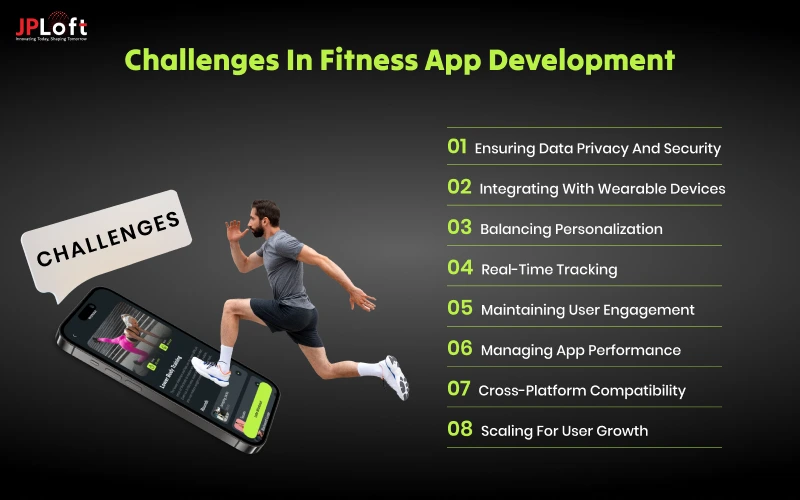
Building a fitness app comes with unique challenges that require careful planning and strategic solutions. Here are some of the main challenges in developing a fitness app, along with effective ways to tackle them:
1. Ensuring Data Privacy and Security
Challenge: Fitness apps collect sensitive user data, including health metrics, which can create security and privacy risks. Ensuring data protection is crucial to gain users’ trust and meet legal requirements.
Solution: Implement robust encryption methods and comply with data protection regulations like GDPR. Using secure servers and regularly updating security protocols can help protect user information. For added security, consider two-factor authentication (2FA) to safeguard user accounts.
2. Integrating with Wearable Devices
Challenge: Many users expect fitness apps to sync with wearables like Fitbits, Apple Watches, and other fitness trackers. However, achieving smooth integration across different devices and brands can be complex.
Solution: Use established APIs from popular wearables to streamline integration and compatibility. Regularly test integrations to ensure seamless data flow and functionality. This compatibility will enhance user experience by allowing continuous tracking and syncing across platforms.
3. Balancing Personalization with Usability
Challenge: Personalization is essential in fitness apps, but excessive customization can make the app complicated and overwhelming, especially for new users.
Solution: Focus on intuitive design principles and implement a clear onboarding process to guide users through the personalization options. Use AI-driven recommendations to offer relevant content without overloading the user. Keep the interface simple, only presenting advanced customization options as users become more familiar with the app.
4. Providing Accurate and Real-Time Tracking
Challenge: Accurate tracking of activities like heart rate, distance, and calories burned is a fundamental requirement in fitness apps, but inaccuracies can frustrate users and harm app credibility.
Solution: Regularly calibrate algorithms and use reliable APIs for activity and health data. Testing tracking features across various devices ensures the data’s accuracy. For advanced tracking, consider working with specialists in sports science or health metrics to fine-tune accuracy.
5. Maintaining User Engagement Over Time
Challenge: Many users start using fitness apps enthusiastically but may lose interest over time. Ensuring long-term engagement is crucial for retention.
Solution: Introduce gamification elements like challenges, rewards, and leaderboards to keep users motivated. Regularly update content and offer new workout routines, challenges, or features to maintain user interest. Push notifications with motivational messages or reminders can also help re-engage users.
6. Managing App Performance and Speed
Challenge: Fitness apps often process and display large amounts of data, which can affect app performance and load times. Slow performance can lead to user dissatisfaction and drop-offs.
Solution: Optimize code, compress large files, and use efficient data handling methods to ensure smooth performance. Load critical features first, and consider implementing background loading for non-essential elements. Regular testing and optimization are essential to maintain high performance.
7. Addressing Cross-Platform Compatibility
Challenge: Users expect a consistent experience whether they’re on iOS, Android, or using a web version. However, developing for multiple platforms adds complexity.
Solution: Use cross-platform development frameworks like React Native or Flutter to ensure consistent functionality and design across platforms. Test the app thoroughly on each platform to identify any differences in performance, design, or usability and adjust accordingly.
8. Scaling for User Growth and High Demand
Challenge: As the user base grows, app performance may decline if the back-end infrastructure isn’t equipped to handle high demand.
Solution: Choose a scalable architecture from the beginning. Cloud solutions like AWS or Google Cloud offer flexible options for data storage and processing power that can expand as user numbers grow. Proactively monitor performance metrics to adjust resources as needed.
Addressing these challenges effectively can ensure that your fitness app not only meets user expectations but also offers a seamless and secure experience. Thoughtful planning and strategic solutions make it easier to develop a fitness app that stands out in a competitive market.
Here’s the How to Monetize a Fitness App section, outlining major monetization strategies tailored to fitness apps.
How to Monetize a Fitness App?

Monetizing a fitness app is crucial for sustaining development and providing ongoing value to users.
Here are several effective strategies that can generate revenue while enhancing the user experience:
1] Subscription-Based Model
The subscription model is one of the most popular and reliable monetization strategies for fitness apps.
Users pay a recurring fee—monthly, quarterly, or yearly—to access premium features such as exclusive workout plans, personalized coaching, or advanced tracking metrics.
Offering different subscription tiers (e.g., basic, pro, elite) lets users choose based on their needs and budget, increasing the chances of conversions.
Example: Fitbod offers monthly and yearly subscription plans for premium access to customized workouts and analytics.
2] Freemium Model with In-App Purchases
In the freemium model, users have access to basic app features for free, while advanced features require one-time in-app purchases.
This model allows users to experience the app’s core functionality before deciding to invest in extras like specialized workout programs, diet plans, or virtual coaching sessions.
Example: MyFitnessPal provides a basic calorie counter for free but charges for features like deeper nutritional insights, customized goals, and ad-free usage.
3] Paid App Downloads
Although less common in the fitness industry, some apps charge a one-time download fee.
This can work well if the app offers unique features or specialized services that aren’t readily available in free apps.
However, it’s essential to offer substantial value to justify the upfront cost, as users are accustomed to freemium or subscription models in the fitness space.
Example: Seconds Pro charges a one-time fee for its advanced interval timer, catering to users who need a specialized tool for workouts.
4] In-App Advertising
In-app ads allow free access to the app while generating revenue through advertisements.
Ads can be displayed in various formats, including banner ads, video ads, and native ads.
Careful ad placement and ad frequency are essential to prevent disrupting the user experience.
For higher engagement, fitness apps can partner with health-related brands for targeted advertising, ensuring relevance to users.
Example: Freeletics offers ad-supported free content with the option to pay for an ad-free experience.
5] Sponsored Content and Partnerships
Partnering with fitness brands, gyms, or wellness influencers allows the app to offer sponsored content, such as branded workout plans, tutorials, or wellness products.
Sponsorships can create additional value for users by providing exclusive content or discounts while generating revenue for the app.
Collaborating with well-known brands also adds credibility and increases the app’s appeal.
Example: Nike Training Club collaborates with athletes and fitness experts to create branded workout programs, enhancing content quality and appeal.
6] Affiliate Marketing
Affiliate marketing involves promoting products or services from other brands within the app.
Users can purchase recommended fitness gear, supplements, or training equipment directly through affiliate links, and the app earns a commission on each sale.
This approach works best when affiliate products align with the app’s fitness focus, adding value for users while generating passive revenue.
Example: A fitness app might recommend wearable fitness devices or training equipment and earn a commission from each sale.
7] Selling Physical Products
For brands that have a presence in the fitness industry, the app can also serve as a sales channel for branded merchandise, such as apparel, supplements, or fitness gear.
Offering products directly within the app adds a retail component to the app, strengthening the brand’s ecosystem and creating another revenue stream.
Example: Peloton sells branded apparel and fitness accessories through its app, providing an integrated shopping experience for users.
8] Corporate Wellness Programs
Corporate wellness programs are an emerging trend in the fitness app industry.
By offering packages for businesses, fitness apps can provide their services to employees as part of corporate wellness initiatives.
This strategy can significantly increase user numbers while generating steady revenue from corporate clients.
Example: Calm partners with businesses to offer wellness subscriptions to employees, focusing on mindfulness and stress management.
By strategically combining these monetization models, fitness apps can increase their revenue potential while offering diverse options that enhance the user experience. Choosing the right monetization methods depends on your app’s unique value proposition, target audience, and the features offered.
Ready to Develop Your Own Fitness App?
If you’re looking to create a custom fitness app that stands out in a competitive market, partnering with an expert development team is essential.
At JPloft, a leading fitness app development company, we specialize in building feature-rich, user-friendly apps tailored to your brand’s unique goals.
From personalized coaching and workout tracking to advanced integrations with wearable devices, we understand what it takes to bring your vision to life.
Our team works closely with you throughout every stage of the process, ensuring that your app is crafted with precision, security, and scalability.
Let’s discuss how we can turn your fitness app concept into a valuable tool that keeps users engaged and motivated.
Get in touch with JPloft to start your journey in building a successful fitness app today.
Conclusion
Developing a fitness app offers exciting opportunities to connect with a health-focused audience and create a platform that supports users in achieving their wellness goals.
By leveraging the latest technologies, offering a smooth user experience, and including valuable features, you can build an app that stands out in a crowded market.
Whether you aim to monetize through subscriptions, in-app purchases, or partnerships, a well-planned fitness app has the potential to grow and thrive.
As fitness trends continue to evolve, your app can adapt, delivering ongoing value and cultivating a loyal user base.
Ready to get started? With the right approach, your fitness app could become a trusted companion for users worldwide on their health journeys.
FAQs
The development timeline for a fitness app depends on its complexity and feature set. On average, a basic fitness app can take around 3–6 months, while more complex apps with advanced features may take 6–12 months or longer.
The cost of developing a fitness app varies based on features, platform, and level of customization. A simple app may cost between $40,000 and $80,000, while a more advanced app with AI, integrations, and custom features can range from $100,000 to $200,000.
To reach the widest audience, developing your app for both iOS and Android platforms is ideal. Alternatively, you can consider cross-platform development for a single codebase that works on both systems, reducing time and cost.
Key features in a fitness app typically include workout tracking, user profiles, personalized recommendations, wearable integration, and push notifications. Advanced features like AI-driven coaching, gamification, and social sharing can further enhance the app’s appeal.
Common monetization strategies include subscription plans, in-app purchases, ads, and partnerships with brands. Choosing the right model depends on your app’s goals and user expectations.
Data security is essential, especially when handling sensitive health data. We implement industry-standard encryption, secure APIs, and compliance with regulations like GDPR to protect user information and maintain privacy.
Yes, we can continuously enhance your app with new features and updates based on user feedback and market trends. Regular updates keep the app relevant and can improve user engagement over time.
Absolutely. We provide ongoing support and maintenance services to ensure that your app remains secure, performs optimally, and adapts to user needs and technological advancements.





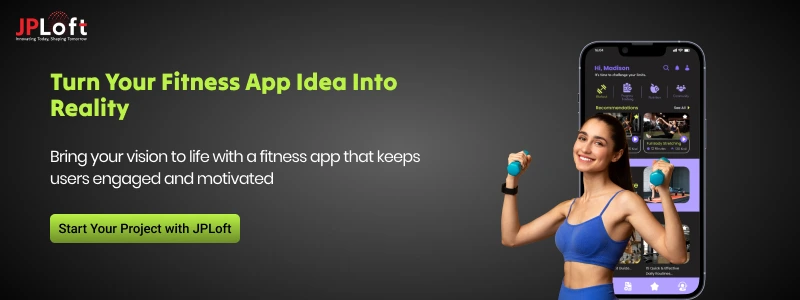
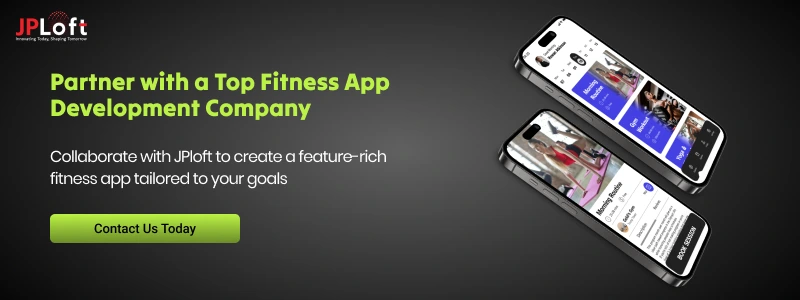
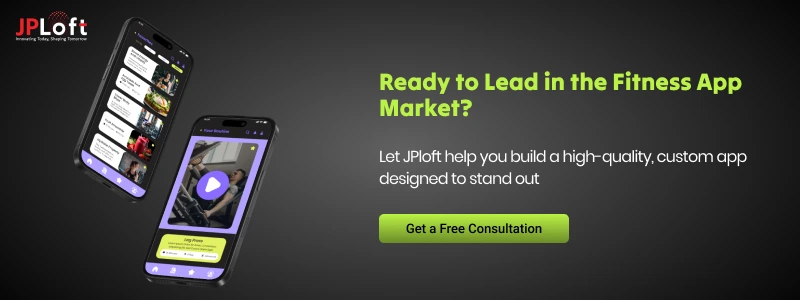

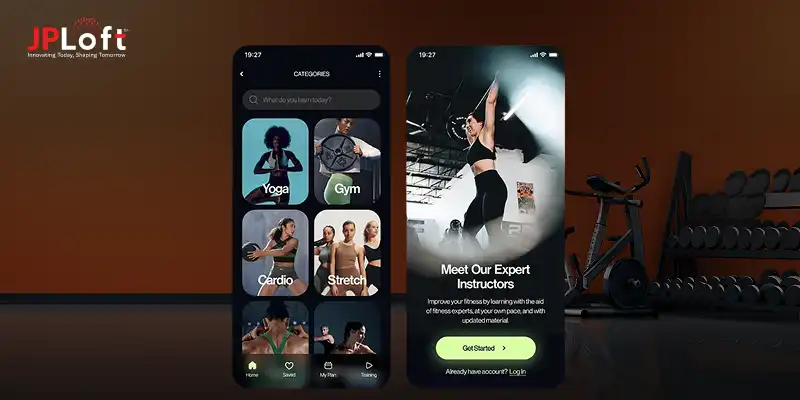
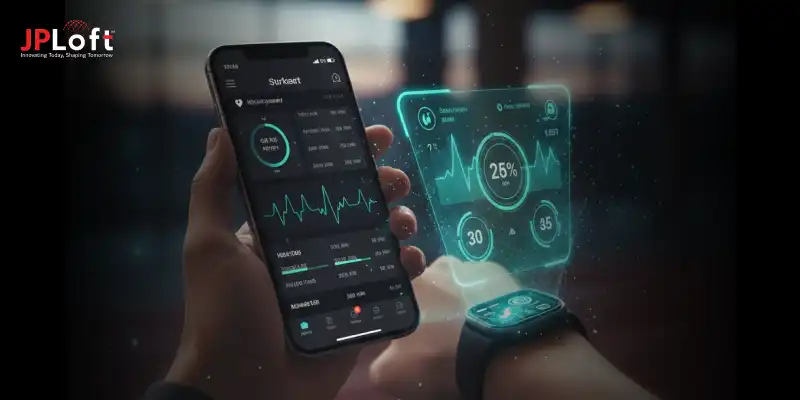
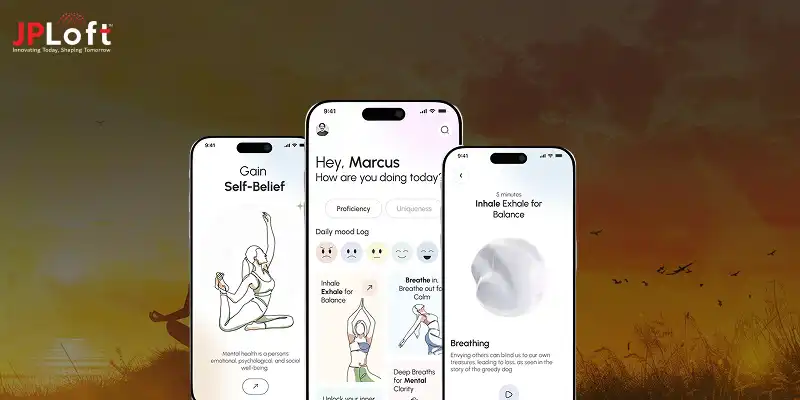


Share this blog